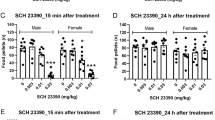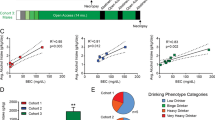Abstract
THE question of whether nicotine, the neuroactive compound of tobacco, is addictive has been open to considerable scientific and public discussion. Although it can serve as a positive reinforcer in several animal species, including man, nicotine is thought to be a weak reinforcer in comparison with addictive drugs such as cocaine and heroin1,2, and has been argued to be habit forming but not addictive3,4. Here we report that intravenous nicotine in the rat, at doses known to maintain self-administration, stimulates local energy metabolism, as measured by 2-deoxyglucose autoradiography, and dopamine transmission, as estimated by brain microdialysis, in the shell of the nucleus accumbens. These neurochemical and metabolic effects are qualitatively similar to those of other drugs, such as cocaine, amphetamine and morphine, which have strong addictive properties5–7. Our results provide functional and neurochemical evidence that there are specific neurobiological commonalities between nicotine and addictive drugs.
This is a preview of subscription content, access via your institution
Access options
Subscribe to this journal
Receive 51 print issues and online access
$199.00 per year
only $3.90 per issue
Buy this article
- Purchase on Springer Link
- Instant access to full article PDF
Prices may be subject to local taxes which are calculated during checkout
Similar content being viewed by others
References
Stolerman, I. P. in Handbook of Psychopharmacology (eds Iversen, L. L, Iversen, L. D. & Snyder, S. H.) 421–465 (Plenum, New York, 1987).
Swedberg, M. D. B., Henningfield, J. E. & Goldberg, S. R. in Nicotine Psychopharmacology: Molecular, Cellular and Behavioral Aspects (eds Wonnacott, S., Russell, M. A. H. & Stolerman, I. P.) 38–76 (Oxford Science, Oxford, 1990).
Robinson, J. H. & Pritchards, W. S. Psychopharmacology 108, 397–407 (1992).
Warburton, D. M., Revell, A. & Walters, A. C. in The Pharmacology of Nicotine (eds Rand, M. & Thurau, K.) 359–373 (IRL, Oxford, 1989).
Pontieri, F. E. et al. NeuroReport 5, 2561–2564 (1994).
Orzi, F. et al. Eur. J. Pharmac. (in the press).
Pontieri, F. E., Tanda, G. & Di Chiara, G. Proc. natn. Acad. Sci. U.S.A. 92, 12304–12308 (1995).
Wise, R. A. & Bozarth, M. A. Psychol. Rev. 94, 469–492 (1987).
Koob, G. F. Trends pharmac. Sci. 13, 177–184 (1992).
Di Chiara, G. Drug Alcohol Depend. 38, 95–121 (1995).
Di Chiara, G. & Imperato, A. Proc. natn. Acad. Sci. U.S.A. 88, 5274–5278 (1988).
Alheid, G. F. & Heimer, L. Neuroscience 27, 1–39 (1988).
Heimer, L. et al. Neuroscience 41, 89–125 (1991).
Corrigall, W. A. & Coen, K. M. Psychopharmacology 99, 473–478 (1989).
Corrigall, W. A. in Effects of Nicotine on Biological Systems (eds Adklofer, F. & Thurau, K.) 423–432 (Birkhauser, Boston, 1991).
Sokoloff, L. et al. J. Neurochem. 28, 897–916 (1977).
Ungerstedt, U. in Measurement of Neurotransmitter Release in Vivo (ed. Marsden, C. A.) 81–105 (Wiley, Chichester, 1984).
Di Chiara, G. Trends pharmac. Sci. 11, 116–121 (1990).
London, E. D. et al. J. Neurosci. 8, 3920–3928 (1988).
McNamara, D. et al. J. cerebr. Blood Flow Metab. 10, 48–56 (1990).
Grunwald, F., Schrock, H. & Kuschinsky, W. Brain Res. 400, 232–238 (1987).
Porrino, L. J. Psychopharmacology 112, 343–351 (1993).
Imperato, A., Mulas, A. & Di Chiara, G. Eur. J. Pharmac. 132, 337–338 (1986).
Damsma, G., Day, J. & Fibiger, N. C. Eur. J. Pharmac. 168, 368–371 (1989).
Henningfield, J. E. & Heishman, S. J. Psychopharmacology 117, 11–13 (1995).
Tiffany, S. T. Psychol. Rev. 97, 147–168 (1990).
Crane, A. M. & Porrino, L J. Brain Res. 499, 87–92 (1989).
Paxinos, G. & Watson, C. The Rat Brain in Stereotaxic Coordinates (Academic, Sydney, 1987).
Author information
Authors and Affiliations
Rights and permissions
About this article
Cite this article
Pontieri, F., Tanda, G., Orzi, F. et al. Effects of nicotine on the nucleus accumbens and similarity to those of addictive drugs. Nature 382, 255–257 (1996). https://doi.org/10.1038/382255a0
Received:
Accepted:
Issue Date:
DOI: https://doi.org/10.1038/382255a0
This article is cited by
-
Cholinergic system adaptations are associated with cognitive function in people recently abstinent from smoking: a (-)-[18F]flubatine PET study
Neuropsychopharmacology (2023)
-
A glutamatergic DRN–VTA pathway modulates neuropathic pain and comorbid anhedonia-like behavior in mice
Nature Communications (2023)
-
Drug addiction: from bench to bedside
Translational Psychiatry (2021)
-
Developing and testing the effectiveness of a novel online integrated treatment for problem gambling and tobacco smoking: a protocol for an open-label randomized controlled trial
Trials (2020)
-
The acute effects of nicotine on corticostriatal responses to distinct phases of reward processing
Neuropsychopharmacology (2020)
Comments
By submitting a comment you agree to abide by our Terms and Community Guidelines. If you find something abusive or that does not comply with our terms or guidelines please flag it as inappropriate.



